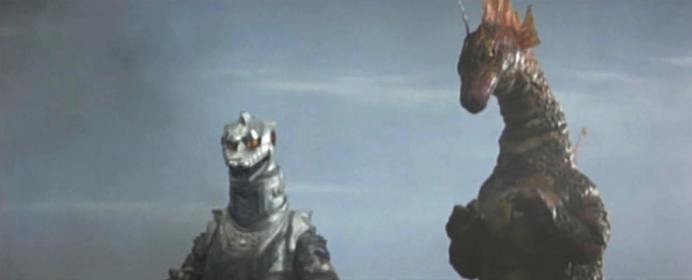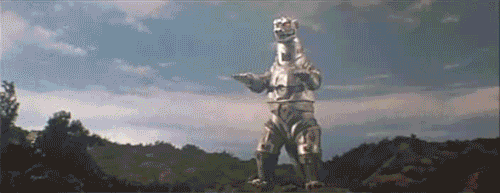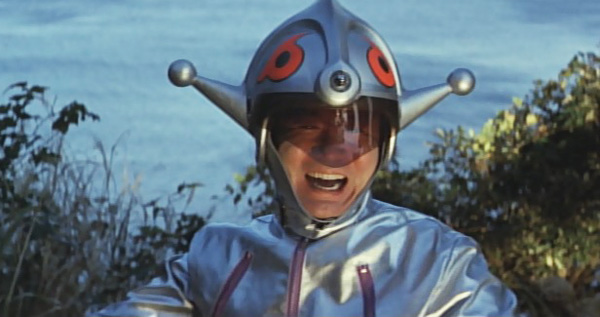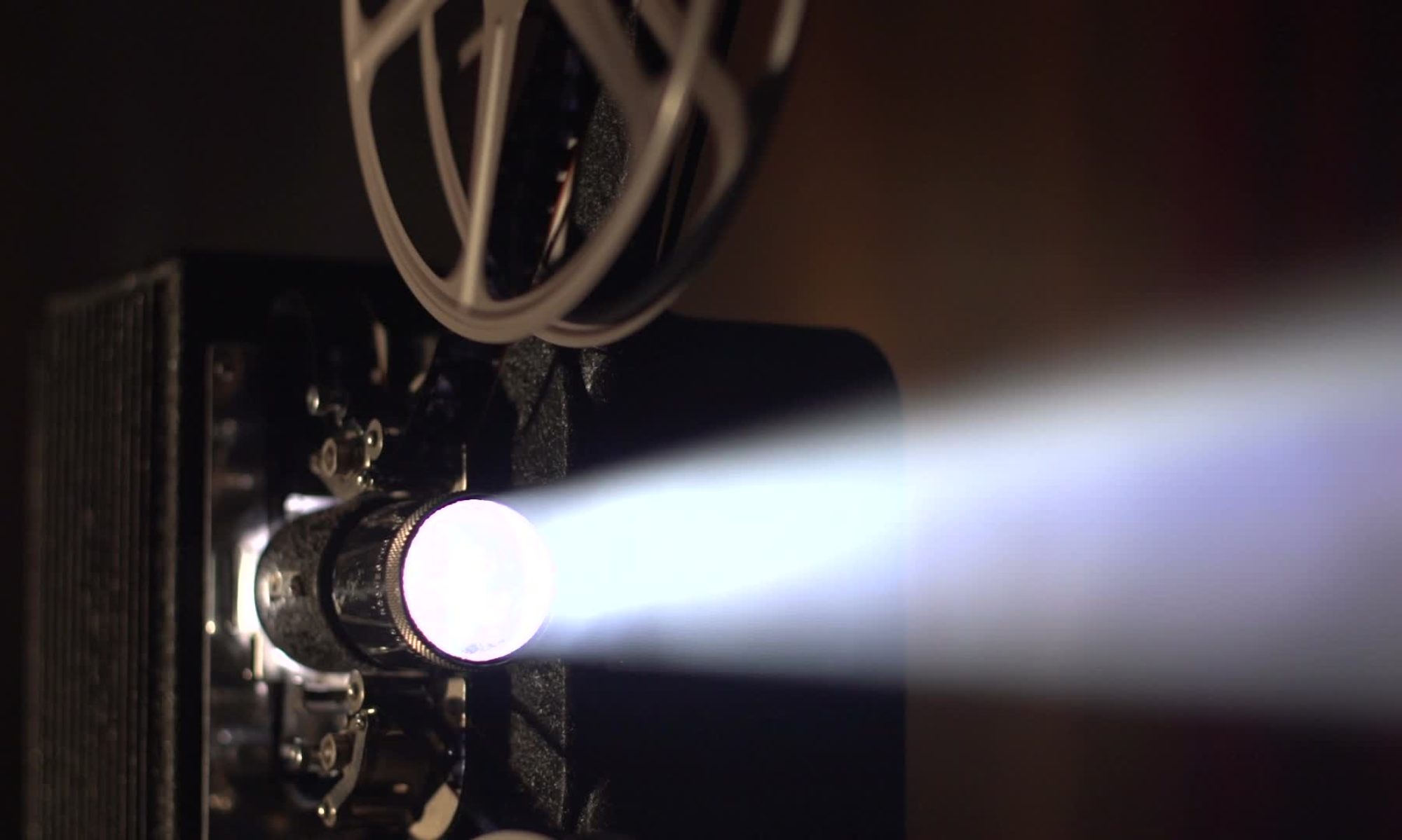
When most people talk about their favorite Godzilla movies, Godzilla vs Mechagodzilla (1974) is generally in the list. While I have absolutely nothing against that movie, and often quite enjoy it, I’ve always found myself more fond of its direct sequel, Ishiro Honda’s swan song, Terror of Mechagodzilla (1975).
What is Terror of Mechagodzilla?
Terror of Mechagodzilla was the last film in the declining Godzilla series before the decade long drought until The Return of Godzilla (Godzilla 1985). Toho Studios had originally intended to end the series with 1968’s Destroy all Monsters which included most of their most popular monsters and ended in a final battle to die for. However, that film’s box office success prompted Toho Studios to keep the series rolling for a little longer. Sadly, by then, the Godzilla series was beset by strong competition both in theaters and on television which forced Toho to gradually reduce budgets and increasingly use gimmicks to pull in audiences.
Jun Fukuda’s 1974 classic, Godzilla vs Mechagodzilla, was a moderate box office success in comparison to the two previous films, Godzilla vs Gigan and Godzilla vs Megalon, which lead, naturally, to a rematch between the two. Godzilla co-creator and director of Gojira (1954), Ishiro Honda, resumed directing duties one last time before retirement and gave audiences a drastically different film from the original bought. The Terror of Mechagodzilla’s plot moved away from some of the campier elements of the first film while still maintaining the general outline (robot Godzilla, alien invasion etc.)
In the end, Terror of Mechagodzilla was a box office bomb, becoming the least successful film in the entire series and sealing its fate for a, then, indefinite period of time. The film was later dubbed and released direct to video and television in the United States and became a minor success. In retrospect, the film is generally viewed positively by most Godzilla fans.
What is Terror of Mechagodzilla About?
Relatively rare for a Godzilla movie, Terror of Mechagodzilla is a direct sequel to the prior film, Godzilla vs Mechagodzilla. An Interpol research submarine is sent into the Okinawa Sea in search of Mechagodzilla’s remains. However, the space robot seems to have disappeared without a trace, and the sub is quickly attacked and destroyed by a new creature, Titanosaurus.
Back at Interpol, the final transmission of the submarine is deciphered, revealing that the sub was attacked by a “dinosaur” of some kind. Perhaps more disturbing, photographs of what appear to be UFOs were recovered from near the sight where the submarine disappeared. Further research is performed and it is discovered that the dinosaur may be none other than the Titanosaurus that Dr. Mifune, a marine biologist, had claimed to have discovered 20 years earlier. However, as the agents attempt to track Dr. Mifune down for more information, they discover that he was ridiculed and eventually ostracized for his claim, as well as his belief that he could somehow control the monster.
Arriving at his old home in Minazuru, they find his daughter, Katsura, who informs the agents that her father has been dead for 5 years and that she burned all of his notes after his passing. In truth, Dr. Mifune is very much alive with a grudge against humanity, and is working with the Aliens of the 3rd Planet of the Black Hole. Their plan; to repair the recently salvaged Mechagodzilla and, in unison with Titanosaurus, destroy Godzilla and wipe humanity from the face of the earth, claiming it for themselves.

What Happens in Terror of Mechagodzilla?
One huge distinction between Godzilla vs Mechagodzilla and Terror of Mechagodzilla is the increased focus on the human plot in the second film. Titanosaurus appears briefly at the beginning of the film, but there is little giant monster activity until about the 45 minute mark. Heck, Godzilla himself doesn’t even appear until almost an hour in, and Mechagodzilla doesn’t resume operation until even after that. All of this leads to most of the film being focused on the human element and the alien invasion plot. Normally, in a Godzilla movie, this would be a problem (look no further than Godzilla 2014 to see why), but it works in Terror of Mechagodzilla.

What really carries Terror of Mechagodzilla’s human plot forward are Dr. Mifune, played by Katsuhiko Susaki, and his daughter Katsura, played by Tomoki Ai. Both roles are well acted and compelling in their own right. Mifune is protrayed as the bitter mad scientist, which is nothing new, but with the interesting twist that, in spite of his utter hatred for humanity, he truly, deeply, loves his daughter. Katsura, on the other hand, struggles constantly between her love for her father and the constant knowledge that what he and the aliens are doing is wrong.
To further complicate matters, it is revealed partway through Terror of Mechagodzilla that Katsura had been killed several years ago in a freak laboratory accident, then revived by the aliens as a cyborg. This could have been handled rather cheesily, as with other plot points in prior Godzilla films, but here it is portrayed as a tragic situation. This, coupled with her other feelings, leaves Katsura struggling with the feeling that, as she herself is not human, the only love she can depend on is that of her father. All of this leads to a remarkable human drama for a Godzilla film that really carries a movie with, relatively, little monster action.
The rest of the story in Terror of Mechagodzilla is fairly standard fair for a Godzilla movie. An evil monster appears, a weakness is found, the situation escalates and it all culminates in a giant monster battle. Aside from Dr. Mifune and Katsura, most of the human characters are pretty bare bones and nothing special, and the alien invasion plot (though handle’d better here than it had been since Monster Zero in 1965) was pretty tired by this point. The only other character of note here is Dr. Ichinose (and, yes, I call him Dr. Itchy Nose) who, aside from being the plain as dirt scientist found in every other Godzilla movie in the Showa Era, manages to be memorable if only for his feelings for Katsura, which adds another element to her stellar plot and leads to one of the most emotionally powerful finales in the entire series.
If I were to name one area where Terror of Mechagodzilla falters in comparison to the first Godzilla vs Mechagodzilla, it’s in how Mecahgodzilla himself is handled. In the first film, he was portrayed as a nigh invincible weapon of mass destruction. Here, however, he is pretty handily overshadowed by, newcomer, Titanosaurus. It doesn’t help that he isn’t even active until the last 15 minutes or so of the film and that, during most of the final battle, he stands in the back like he’s been lobotomized, only firing the occasional laser or missile. Granted, after Titanosaurus has been effectively dispatched, we get to see him launch his whole arsenal as he had in the previous film mono a mono with Godzilla, and the fight ends on a pretty memorable twist to the ending to first final encounter. However this scene is, though a visual marvel, fairly brief and leaves the viewer wishing there had just been a little more, especially when compared to the first film’s final battle. The film is called Terror of Mechagodzilla, but Mechagodzilla himself seems to take a back seat until the last couple of minutes.

How are the Effects in Terror of Mechagodzilla?
Terror of Mechagodzilla boasts one of the more memorable giant monster casts of the Showa series. Mechagodzilla, visually, has only minor, barely distinguishable differences from the first iteration and looks good as a result. The Godzilla suit in use here is the same as in the first Mechagodzilla film and, as such, looks good if a little worn down. However, the real standout here is, newcomer, Titanosaurus.

Titanosaurus was brought into the film as Mechagodzilla’s ally, replacing King Saesar from the first movie who had been Godzilla’s, raising the stakes for the final confrontation. Titanosaurus’s design is memorable and the suit looks fantastic, particularly when wet or shot in the dark. That’s why it’s a bit of a shame that the final battle takes place during the daytime, though I’m sure it made lighting a bit easier.

Terror of Mechagodzilla’s aliens, on the other hand, don’t fair quite as well. In spite of the alien invasion plot being handled much more seriously this time around the alien suits themselves may be some of the cheesiest in the series (aside, maybe, for Monster Zero’s Xiliens who also had a fairly serious invasion plot oddly enough). I have nothing against cheesy alien designs in a Godzilla film, but this time it does seem to be at odds with the film’s more serious tone. Also, sadly, the aliens never turn into apes as they had in the first film which is a bit of a shame seeing as it was their most memorable aspect. It was cheesy, to be sure, but if you’re going to go with this outfit design, why not go all the way?
How is the Soundtrack in Terror of Mechagodzilla?
Masura Sato delivered a suitably cheesy and off beat soundtrack for the entertainingly campy Godzilla vs Mechagodzilla. However, for Terror of Mechagodzilla’s more serious take on the character, perhaps no composer was better suited than the great Akira Ifukube. As always, Ifukube creates a rousing score, bringing back the trademark Godzilla theme, while giving Mechagodzilla a suitably menacing tune. The music during the human segments is strong as well, if not nearly as memorable. Ifukube can turn out a respectable tune for romantic scenes. However, aside from the monster themes, Ifukube knocks it out of the park for the tragic moments, particularly at the ending screen for which he produces, perhaps, the best tear-jerker of the original series.
Overall, Terror of Mechagodzilla gets high marks for Ifukube’s, as always, masterful score. Ifukube is no stranger to Godzilla soundtracks and, though this one is not his best it is one of his more memorable soundtracks.
Is Terror of Mechagodzilla a Good Movie?
The Godzilla series is known for being something of a niche genre. Oddly enough, rubber monsters beating the crap out of eachother in miniature cities is not universally pleasing, but Terror of Mechagodzilla’s strong human plot really helps carry it forward. I would venture to say that even people who aren’t Godzilla fans could still get some enjoyment out of Godzilla and Mechagodzilla’s rematch. Sure, it has it’s elements of 70s cheese and the final battle is as audacious as ever, but this movie is driven by story instead of spectacle.
As stated in the introduction, I have nothing against the highly entertaining Godzilla vs Mechagodzilla. The final battle is undeniably one of the most entertaining of the entire series and the ubber cheesiness of it all really completes the package. However, I find myself watching Terror of Mechagodzilla more often. In spite of a weaker final battle and a far more subdued primary antagonist, it’s strong monster cast, more serious tone and remarkably strong human storytelling really carry this sequel through and manage to make it really compelling. I can totally understand someone preferring the first Mechagodzilla movie to this one but, for me, Terror of Mechagodzilla just has more weight. Definitely recommended.
